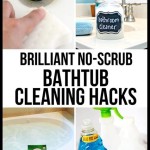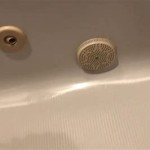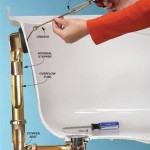How To Tape a Bathtub for Caulking: A Comprehensive Guide
Applying caulk around a bathtub is a fundamental maintenance task for any homeowner. Proper caulking creates a watertight seal, preventing water damage and fostering a hygienic environment. However, achieving a professional finish necessitates meticulous preparation, and taping is a critical component of that process. Correctly applied painter’s tape provides clean, consistent caulk lines, significantly enhancing the aesthetic appeal and longevity of the seal. This article offers a detailed, step-by-step guide on how to tape a bathtub for caulking, covering essential tools, techniques, and troubleshooting tips.
Understanding the Importance of Taping
Taping before caulking is not merely an optional step; it's a crucial element in achieving a flawless result. Without tape, achieving a clean, precise line is exceedingly difficult, even for experienced professionals. The primary benefits of taping include:
Creating Uniform Lines: Tape acts as a physical barrier, ensuring that the caulk line adheres to a consistent width and depth. This uniformity contributes significantly to the overall appearance of the finished project.
Preventing Caulk Smears: Taping confines the caulk application to the designated area, preventing it from spreading onto surrounding surfaces. This minimizes cleanup and avoids unsightly smears on the bathtub or surrounding tiles.
Facilitating Easy Cleanup: Once the caulk is applied and tooled, the tape can be removed, leaving behind a clean, crisp edge. This eliminates the need for meticulous scraping and scrubbing to remove excess caulk.
Protecting Surfaces: The tape provides a protective layer, shielding the bathtub and surrounding tiles from scratches, stains, and other damage that may occur during the caulking process.
Gathering the Necessary Tools and Materials
Before commencing the taping process, ensure that all necessary tools and materials are readily available. This proactive approach minimizes interruptions and ensures a smooth, efficient workflow. The essential items include:
Painter's Tape: Opt for high-quality painter's tape specifically designed for use in wet environments. Blue painter's tape is a common choice, but other types of tape with moisture-resistant properties are also suitable. The width of the tape should be appropriate for the desired caulk line width; typically, 1-inch or 1.5-inch tape is sufficient.
Caulk Remover (Optional): If old caulk needs to be removed, a dedicated caulk remover is essential. These products soften the old caulk, making it easier to scrape away without damaging the surrounding surfaces. Ensure the remover is suitable for the bathtub and tile materials.
Scraper or Utility Knife: A sturdy scraper or utility knife is necessary for removing old caulk. Choose a tool with a sharp blade and a comfortable handle for optimal control and precision.
Cleaning Supplies: A clean surface is essential for proper tape adhesion. Gather cleaning supplies such as a scrub brush, sponge, mild detergent, and clean cloths. A mildew-killing solution may be necessary if mold or mildew is present.
Caulk Gun: A reliable caulk gun is crucial for applying the new caulk. Choose a gun with a smooth trigger action and a comfortable grip for effortless application.
Caulk: Select a high-quality caulk specifically designed for use in bathrooms. Look for a caulk that is mold-resistant, mildew-resistant, and waterproof. Silicone and acrylic latex caulk are common choices.
Caulk Smoothing Tool or Finger: A caulk smoothing tool or a gloved finger can be used to create a smooth, professional finish. These tools help to shape the caulk bead and eliminate any imperfections.
Paper Towels or Rags: Keep paper towels or rags readily available for wiping up any excess caulk or cleaning tools.
Step-by-Step Guide to Taping a Bathtub for Caulking
The following steps outline the process of preparing the bathtub and applying tape for optimal caulking results:
Step 1: Remove Old Caulk (If Necessary): If the existing caulk is cracked, peeling, or moldy, it must be removed before applying new caulk. Apply caulk remover to the old caulk and allow it to sit for the recommended time, as specified by the product instructions. Use a scraper or utility knife to carefully remove the softened caulk. Exercise caution to avoid scratching the bathtub or surrounding tiles. Clean the area thoroughly to remove any remaining residue.
Step 2: Clean the Area Thoroughly: Before applying tape, ensure that the bathtub and surrounding tiles are clean, dry, and free from any soap scum, dirt, or mildew. Scrub the area with a mild detergent and a scrub brush or sponge. Rinse thoroughly with clean water and dry completely with a clean cloth. If mold or mildew is present, apply a mildew-killing solution and allow it to sit for the recommended time before rinsing and drying.
Step 3: Apply the First Layer of Tape: Begin by applying the first layer of tape along the edge of the bathtub, approximately 1/8 to 1/4 inch away from the joint between the bathtub and the wall or floor. This gap will determine the width of the caulk line. Press the tape firmly onto the surface, ensuring that it adheres completely and that there are no air bubbles or wrinkles. Use your finger or a smoothing tool to press the tape down firmly. For curved areas, apply the tape in short, overlapping sections to ensure a smooth, consistent line.
Step 4: Apply the Second Layer of Tape: Apply the second layer of tape along the wall or floor, mirroring the first layer and maintaining a consistent gap. Again, press the tape firmly onto the surface, ensuring that it adheres completely and that there are no air bubbles or wrinkles. It is important for the lines to be parallel to achieve a uniform bead. Work in sections, overlapping the tape slightly at the corners to create a watertight seal.
Step 5: Inspect the Tape Lines: Carefully inspect the tape lines to ensure that they are straight, parallel, and free from any gaps or wrinkles. Address any imperfections before proceeding to the caulking stage. Use a utility knife to trim any excess tape or to create precise corners. If the tape isn't sticking due to moisture, dry the area thoroughly again with a clean cloth or use a heat gun on a low setting for a few seconds to aid adhesion.
Step 6: Apply the Caulk: Once the tape is securely in place, load the caulk into the caulk gun and carefully apply a bead of caulk along the joint between the bathtub and the wall or floor. Maintain a consistent pressure on the trigger to ensure a uniform bead. Overlap the caulk slightly onto the tape on both sides.
Step 7: Tool the Caulk: Immediately after applying the caulk, use a caulk smoothing tool or a gloved finger to smooth the bead and press it firmly into the joint. Remove any excess caulk with a damp cloth or paper towel. Clean the smoothing tool frequently to prevent buildup.
Step 8: Remove the Tape: After tooling the caulk, carefully remove the tape while the caulk is still wet. Pull the tape away from the caulk line at a 45-degree angle to prevent the caulk from pulling away from the joint. Dispose of the tape properly.
Step 9: Inspect and Touch Up: After removing the tape, inspect the caulk line for any imperfections. Use a damp cloth or a caulk smoothing tool to touch up any areas that require attention. Allow the caulk to cure completely according to the manufacturer's instructions before using the bathtub or shower.
Troubleshooting Common Taping Issues
Even with careful preparation, certain challenges may arise during the taping process. Understanding these issues and their solutions can help ensure a successful outcome.
Tape Not Adhering Properly: If the tape is not adhering properly, the surface may be dirty, damp, or uneven. Ensure that the surface is thoroughly cleaned and dried before applying the tape. If the surface is uneven, use a flexible tape that can conform to the contours. Applying a primer specifically designed for tape adhesion can also improve the bond.
Tape Tearing When Removed: If the tape is tearing when removed, the caulk may be too dry or the tape may be too old. Remove the tape immediately after tooling the caulk, while it is still wet. Use high-quality painter's tape that is designed for easy removal. Applying a thin layer of release agent to the tape before caulking can also prevent tearing.
Uneven Caulk Lines: Uneven caulk lines can result from inconsistent tape placement or uneven caulk application. Ensure that the tape lines are straight, parallel, and consistent in width. Maintain a consistent pressure on the caulk gun trigger and use a caulk smoothing tool to create a uniform bead.
Caulk Smearing After Tape Removal: Caulk smearing after tape removal can occur if the caulk is still too wet or if the tape is removed at the wrong angle. Allow the caulk to set for a few minutes before removing the tape, but not so long that it dries completely. Pull the tape away from the caulk line at a 45-degree angle to prevent smearing.
By meticulously following these steps and addressing any potential challenges proactively, a homeowner can effectively tape a bathtub for caulking, resulting in a professional-looking, watertight seal. This attention to detail not only enhances the aesthetic appeal of the bathroom but also protects against costly water damage and promotes a healthier living environment.

Caulk Your Tub With Blue Tape Easily Quick Tip

How To Caulk A Shower Or Bathtub Diy Family Handyman

How To Get A Super Smooth Caulking Line Using Tape

How To Caulk A Bathtub 13 Steps With Pictures Wikihow

How To Caulk A Bathtub 13 Steps With Pictures Wikihow

Prevent Water Damage Replace The Old Caulk Around Your Tub 1 Tom Plumber

Most People Are Re Caulking Their Bathtub Wrong Here S The Right Way

How To Caulk A Bathtub 13 Steps With Pictures Wikihow

How To Caulk Like A Pro Tutorial Nest For Less

How To Re Caulk A Bathtub








